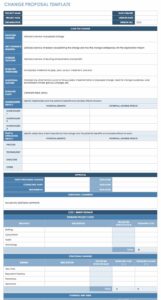Utilizing standardized change forms provides several advantages. They streamline the change management process, minimizing errors and delays. Clear documentation supports better risk assessment, impact analysis, and informed decision-making. Formalized procedures enhance traceability and accountability, contributing to improved service stability and reduced disruptions.
This article delves further into various aspects of change management within the ITIL context. Subsequent sections will explore topics such as change categorization, authorization processes, emergency change procedures, and the integration of change management with other ITIL processes.
Key Components of an ITIL-aligned Change Request
Effective change management hinges on capturing comprehensive information about proposed modifications. Standardized change request forms ensure consistent data collection, facilitating thorough assessment and informed decision-making.
1. Change Identifier: A unique identifier allows easy tracking and referencing throughout the change lifecycle.
2. Change Title: A concise, descriptive title summarizes the change’s objective.
3. Change Description: A detailed explanation of the proposed modification, including its scope and rationale.
4. Impact Assessment: Analysis of potential effects on services, systems, and users, including anticipated downtime.
5. Implementation Plan: Steps involved in implementing the change, including timelines, resources, and responsibilities.
6. Rollback Plan: Procedures for reverting the change if issues arise during or after implementation.
7. Testing and Verification: Details of testing procedures to validate the change’s effectiveness and stability.
8. Authorization: Signatures or approvals from relevant stakeholders, demonstrating agreement and accountability.
Complete and accurate information within each component ensures transparency, supports effective communication, and facilitates successful change implementation.
How to Create an ITIL-Aligned Change Request Template
Creating a robust change request template is crucial for effective ITIL-based change management. A well-designed template ensures consistent data collection, facilitates thorough assessments, and streamlines the change process.
1. Define Scope and Purpose: Clearly define the types of changes the template will cover (e.g., standard, emergency). Align the template with organizational change management policies and procedures.
2. Incorporate Key Fields: Include essential fields such as a unique identifier, change title, description, impact assessment, implementation plan, rollback plan, testing procedures, and authorization sections.
3. Structure for Clarity: Organize the template logically to facilitate easy navigation and completion. Use clear headings, concise instructions, and appropriate formatting.
4. Ensure Accessibility: Make the template readily accessible to all stakeholders involved in the change process. Consider using a centralized repository or a readily available platform.
5. Pilot and Refine: Pilot test the template with a representative group of users to identify areas for improvement. Refine the template based on feedback and practical experience.
6. Document Usage Guidelines: Provide clear instructions on how to complete the template, including guidance on filling out each section. Include examples to illustrate best practices.
7. Integrate with Tools: Consider integration with ITSM tools for automated workflow, tracking, and reporting capabilities, further enhancing efficiency.
A well-defined and implemented change request template provides a structured framework, ensuring comprehensive information capture, fostering informed decision-making, and contributing to successful change implementation.
Standardized forms for requesting IT changes within an ITIL framework provide a structured approach to managing modifications, ensuring clear communication, comprehensive documentation, and effective risk assessment. From capturing essential details like impact analysis and implementation plans to facilitating approvals and rollback procedures, these templates play a vital role in minimizing disruptions and maintaining service stability. A well-defined template, coupled with robust processes, empowers organizations to navigate change effectively, contributing to improved IT service delivery and overall operational efficiency.
Effective change management is not merely a procedural necessity; it’s a strategic imperative. Organizations that prioritize the development, implementation, and continuous improvement of standardized change processes are better positioned to adapt to evolving business needs, mitigate risks, and achieve desired outcomes. Embracing structured change management practices ultimately contributes to a more resilient and responsive IT landscape.
